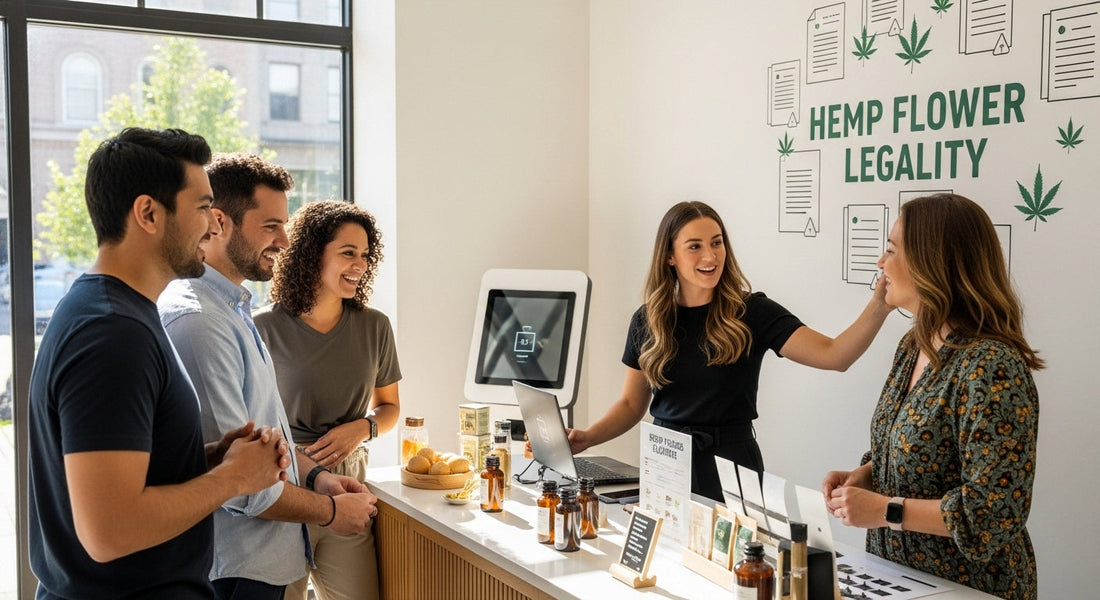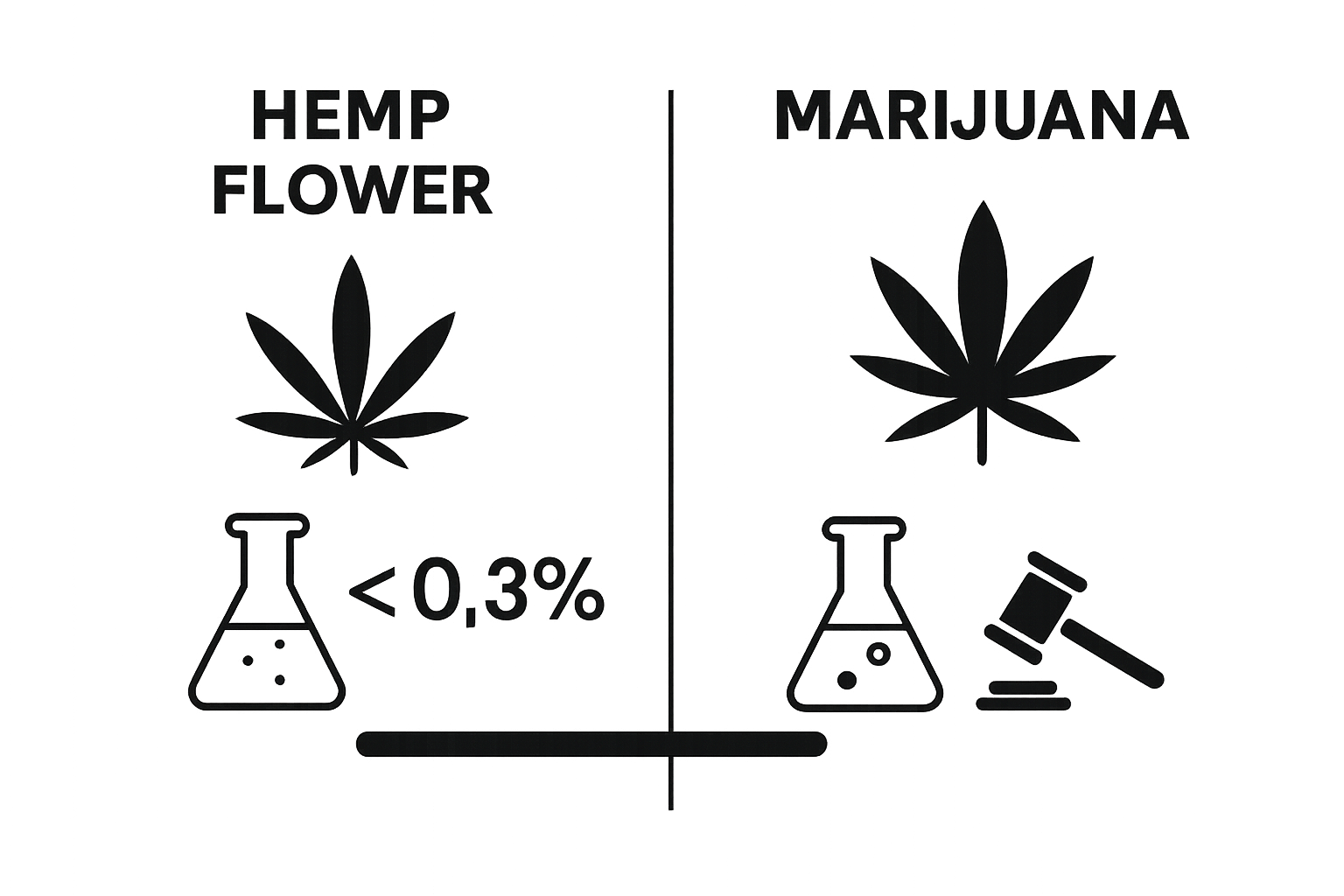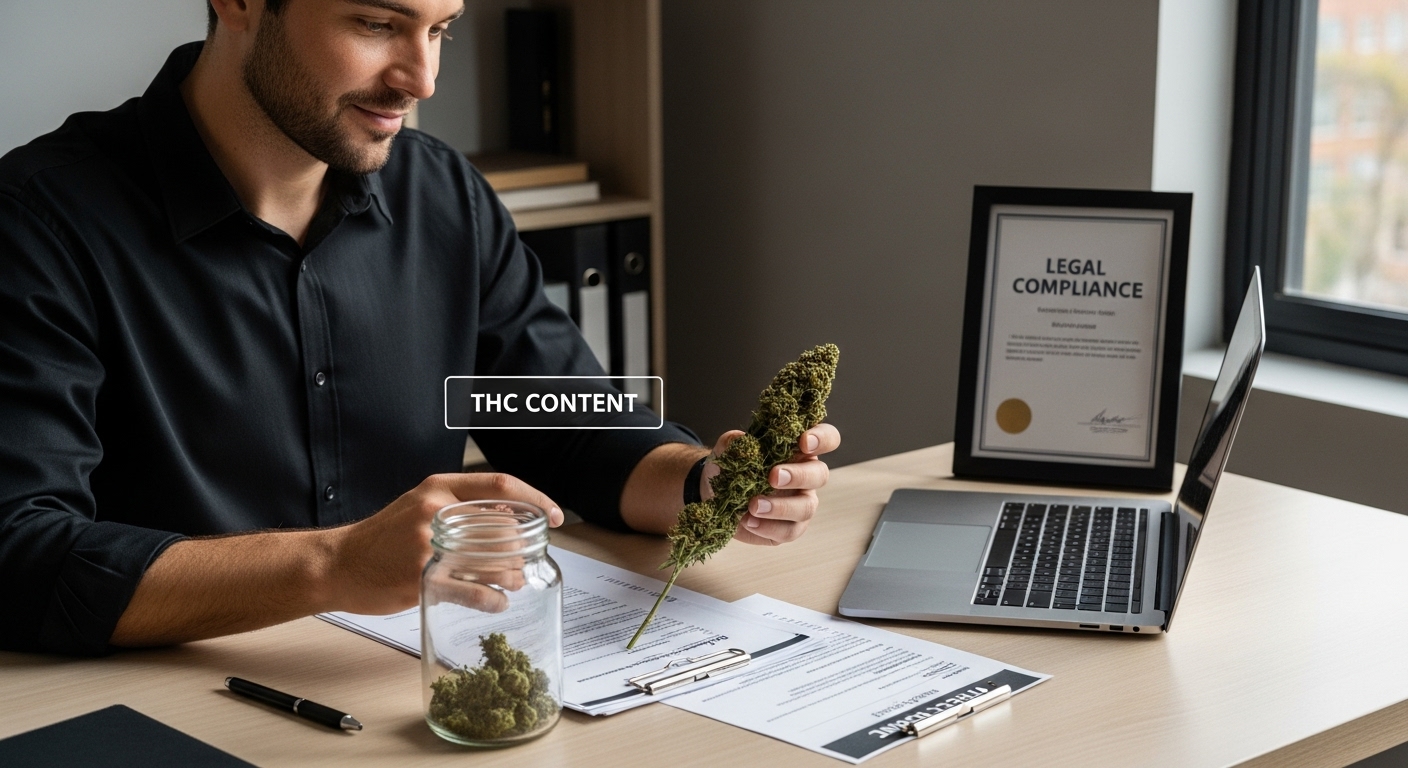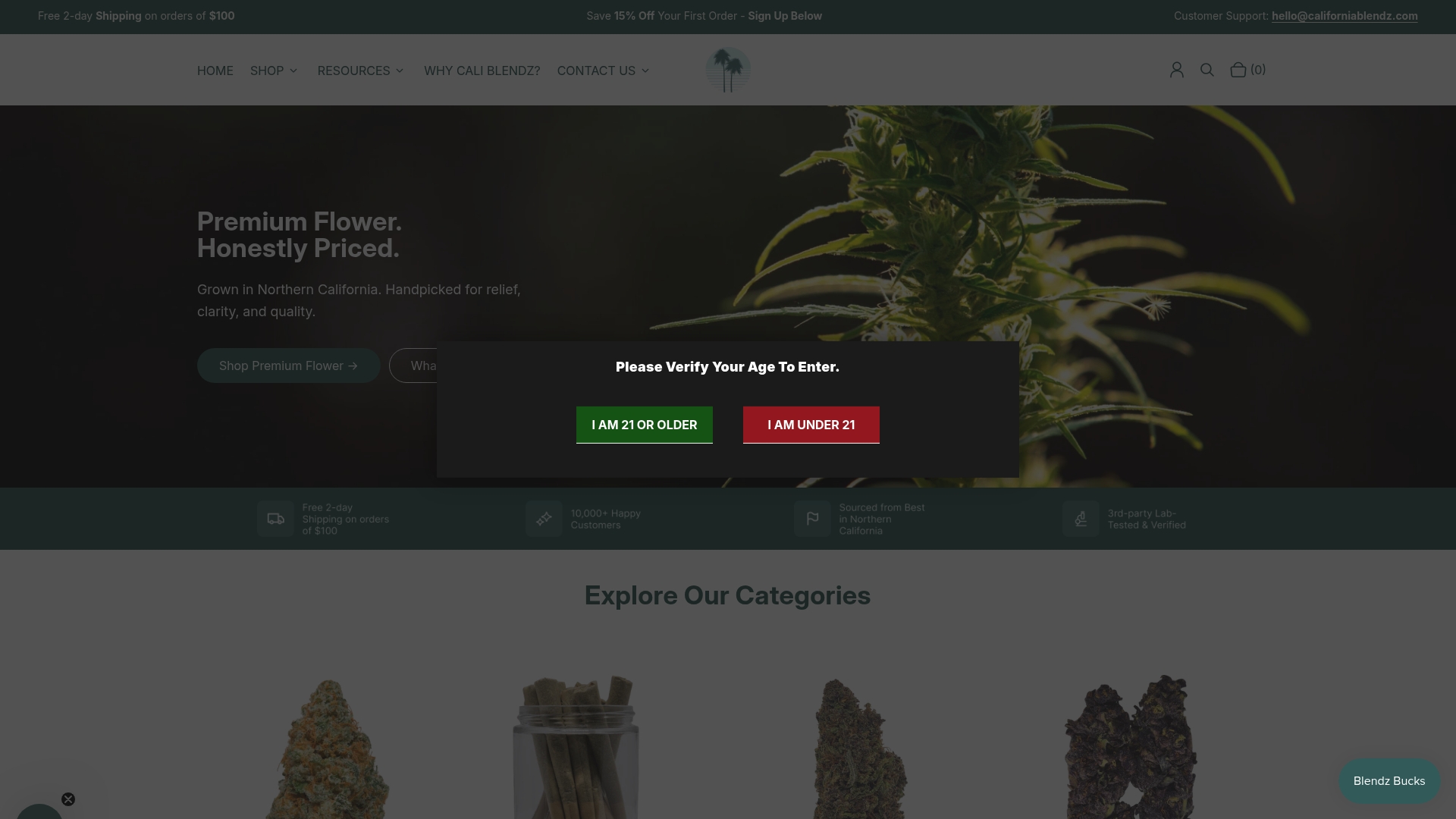Understanding Hemp Flower Legality: A Comprehensive Guide
Written by California Blendz

Hemp flower is making waves as people look for safer, natural wellness options. Most folks are surprised to learn that hemp flower legally contains less than 0.3 percent THC by dry weight, making it totally different from marijuana. But what confuses almost everyone is that the legal status can flip completely just by crossing a state line. The real story behind hemp flower is way more complicated than most people think.
Table of Contents
- What Is Hemp Flower And Why Does It Matter?
- The Legal Background Of Hemp Flower In The U.S.
- Understanding State Vs. Federal Hemp Flower Regulations
- The Role Of THC Levels In Hemp Flower Legality
- Practical Implications For Consumers And Businesses
Quick Summary
| Takeaway | Explanation |
|---|---|
| Hemp flower has low THC content | Hemp flower contains less than 0.3% THC, making it legal and non-intoxicating compared to marijuana. |
| Regulatory landscape is complex | Federal and state laws regarding hemp flower vary significantly, impacting legality and availability. |
| Consumers need to verify product compliance | It’s crucial for consumers to check THC levels and local regulations before purchasing hemp flower products. |
| Hemp flower offers wellness benefits | Hemp flower contains beneficial cannabinoids like CBD, making it a popular choice for natural wellness solutions. |
| Businesses face strict compliance requirements | Companies must adhere to rigorous testing and documentation standards to ensure legal operation in the hemp market. |
What is Hemp Flower and Why Does It Matter?
Hemp flower represents the raw, unprocessed flowering buds of the industrial hemp plant, a versatile botanical product gaining significant attention in wellness and therapeutic markets. Unlike marijuana, hemp flower contains minimal psychoactive compounds, making it a legal and accessible option for consumers seeking natural wellness solutions.
Understanding Hemp Flower Anatomy
Hemp flower consists of the dried and cured flowering tops of Cannabis sativa L. plants specifically cultivated to contain less than 0.3% THC. These flowers are rich in cannabinoids like CBD, CBG, and other non-intoxicating compounds that interact with the human endocannabinoid system. The complex chemical profile of hemp flower makes it valuable for various applications.
The following table organizes the key characteristics of hemp flower described in the article, helping readers quickly identify what sets it apart in terms of composition and legal compliance.
| Characteristic | Description |
|---|---|
| THC Content | Less than 0.3% by dry weight |
| Main Cannabinoids | Rich in CBD, CBG, and other non-intoxicating compounds |
| Source | Industrial hemp plants bred for low psychoactive potential |
| Legal Classification | Defined as an agricultural commodity |
| Cultivation Standards | Carefully grown to meet legal and agricultural standards |
| Regulatory Oversight | Subject to federal and state regulations |
Key characteristics of hemp flower include:
- Contains less than 0.3% THC by dry weight
- Packed with beneficial cannabinoids and terpenes
- Sourced from industrial hemp plants bred for low psychoactive potential
- Carefully cultivated to meet legal and agricultural standards
Significance in Wellness and Legal Frameworks
Hemp flower matters because it represents a legal, accessible pathway to experiencing cannabinoid benefits without intoxication. Research from the FDA highlights its unique position in regulatory landscapes, where it offers potential therapeutic applications while maintaining strict legal compliance.
For consumers interested in exploring hemp flower varieties, our comprehensive guide on finding quality hemp flower provides essential insights into selecting premium products that meet rigorous standards of purity and effectiveness.
The Legal Background of Hemp Flower in the U.S.
The legal landscape of hemp flower in the United States has undergone significant transformation, evolving from strict prohibition to a nuanced regulatory framework that distinguishes hemp from marijuana based on THC content. This complex legal journey reflects changing societal attitudes and scientific understanding of cannabis plants.
The Agricultural Improvement Act of 2018
The pivotal moment for hemp flower legality came with the Agricultural Improvement Act, commonly known as the 2018 Farm Bill. This landmark legislation fundamentally changed how hemp is classified and regulated. The bill definitively established that hemp containing less than 0.3% THC by dry weight would be removed from the Controlled Substances Act, effectively distinguishing it from marijuana and creating a legal pathway for hemp flower production and distribution.
Key legal distinctions include:
- Hemp is now considered an agricultural commodity
- Removal of hemp from Schedule I controlled substances list
- Allows interstate commerce of hemp-derived products
- Permits banking and financial services for hemp businesses
Federal vs State Regulatory Complexities
Research from the Congressional Research Service highlights the intricate legal landscape where federal legalization does not automatically guarantee unrestricted state-level acceptance. While federal law permits hemp flower with under 0.3% THC, individual states maintain the authority to implement stricter regulations or outright prohibitions.
For consumers navigating these complex legal waters, our guide on understanding hemp transportation legalities provides crucial insights into potential legal considerations when possessing or transporting hemp flower across different jurisdictions.
Understanding State vs. Federal Hemp Flower Regulations
The regulatory landscape for hemp flower in the United States represents a complex interplay between federal guidelines and state-level jurisdiction, creating a nuanced legal environment that requires careful navigation by consumers and businesses alike.
Federal Baseline Regulations
Federal law establishes a fundamental framework for hemp flower regulations through the 2018 Farm Bill, which defines legal hemp as cannabis containing less than 0.3% THC by dry weight. This baseline definition creates a national standard that provides some consistency across state boundaries. However, the legislation also explicitly preserves states’ rights to create more restrictive regulations, leading to significant variability in hemp flower legal status.
Key federal regulatory principles include:
- Removal of hemp from Schedule I controlled substances
- Establishing maximum THC concentration at 0.3%
- Creating a pathway for legal hemp cultivation and commerce
- Mandating federal and state regulatory oversight
State Level Regulatory Variations
Research from the National Conference of State Legislatures reveals the dramatic differences in state approaches to hemp flower regulation. Some states have embraced full legalization and created robust hemp industries, while others maintain strict prohibitions or complex licensing requirements that significantly limit hemp flower availability.
Consumers must recognize that what is legal at the federal level may not automatically translate to state-level acceptance. Regulatory differences can impact everything from possession and transportation to cultivation and sales. Our comprehensive guide on cannabis product shipping laws provides additional insights into navigating these complex legal territories.
Understanding these regulatory nuances is crucial for anyone interested in hemp flower, as legal status can change rapidly and varies dramatically between jurisdictions. Consumers and businesses must stay informed about both federal guidelines and specific state regulations to ensure full legal compliance.
The Role of THC Levels in Hemp Flower Legality
THC concentration serves as the critical molecular demarcation between legal hemp flower and controlled marijuana, creating a precise legal boundary that determines the product’s regulatory status and potential market accessibility.
The 0.3% THC Threshold
Federal regulations definitively establish 0.3% THC by dry weight as the pivotal legal threshold for hemp flower. This microscopic percentage represents more than a scientific measurement—it is a legal classification that determines whether a cannabis plant is considered an agricultural commodity or a controlled substance. Products exceeding this THC concentration are legally classified as marijuana, subjecting them to significantly more restrictive regulatory frameworks.

Key considerations for THC level measurement include:
- Precise laboratory testing requirements
- Consistent measurement methodology
- Dry weight calculation standards
- Potential seasonal and cultivation variations
Implications of THC Concentration
Research from the National Institute of Justice highlights the complexity of THC measurement, revealing that many hemp samples can inadvertently exceed legal THC limits. This scientific precision means that hemp flower producers must implement rigorous cultivation and testing protocols to maintain legal compliance.
Our comprehensive guide to understanding THC content provides deeper insights into the nuanced world of cannabinoid concentration and its legal implications.
Understanding THC levels goes beyond mere percentage points—it represents a critical intersection of agricultural science, legal framework, and consumer safety. Consumers and producers alike must remain vigilant about these microscopic yet monumentally important measurements that determine a product’s legal status.

Practical Implications for Consumers and Businesses
The complex legal landscape of hemp flower creates a multifaceted environment with significant implications for both consumers and businesses, demanding careful navigation of regulatory requirements and market dynamics.
Consumer Considerations
Consumers must exercise heightened awareness when purchasing hemp flower products, understanding that legal status can vary dramatically between jurisdictions. The intricate regulatory framework requires individuals to verify product compliance, including THC concentration, source documentation, and local legal restrictions.
Key consumer responsibilities include:
- Verifying product THC content through third-party lab testing
- Understanding local and state-specific hemp regulations
- Maintaining documentation of product origin and composition
- Recognizing potential legal risks in transportation and possession
Business Compliance Challenges
Research from the Baker Institute reveals the complex regulatory environment businesses face when producing and distributing hemp flower. Companies must implement rigorous testing protocols, maintain meticulous documentation, and continuously adapt to evolving legal frameworks across different jurisdictions.
Businesses navigating this landscape must develop comprehensive compliance strategies that address potential legal and financial risks. Our guide on understanding cannabis user privacy offers additional insights into managing legal complexities in the hemp industry.
The intersection of federal and state regulations creates a dynamic environment where legal compliance requires constant vigilance. Both consumers and businesses must remain informed, adaptable, and proactive in understanding the nuanced legal landscape surrounding hemp flower products.
Ready to Shop Worry-Free Hemp Flower?
Discovering all the details about hemp flower legality can feel overwhelming. You want high-quality hemp flower that meets the strict 0.3% THC requirement and holds up under both federal and state scrutiny. But how can you find products that are truly compliant, transparent, and trustworthy? At The Founder’s Collection, every selection is handpicked and lab-tested to ensure you never have to question legal standards or product safety.

Experience the confidence that comes with shopping at California Blendz. Explore our curated flower options, view real lab results, and enjoy simple nationwide shipping. If you care about legal compliance, purity, and full transparency, now is the perfect time to shop for your next premium hemp flower. Visit The THCa Prestige Vault for elite THCa buds or browse our full site to build your ideal collection today.
Frequently Asked Questions
What is hemp flower?
Hemp flower refers to the raw, unprocessed flowering buds of the industrial hemp plant, which contains minimal psychoactive compounds and is rich in beneficial cannabinoids like CBD and CBG.
How is hemp flower different from marijuana?
Hemp flower contains less than 0.3% THC, making it non-psychoactive and legal in many areas, while marijuana typically contains higher levels of THC, which can result in intoxication.
To clarify the main differences between hemp flower and marijuana as discussed in the article, the following comparison table summarizes legal status, THC content, and psychoactive effects.
| Feature | Hemp Flower | Marijuana |
|---|---|---|
| Legal Status | Legal federally, but varies by state | Illegal federally, legal in some states |
| THC Content | Less than 0.3% by dry weight | Usually above 0.3%, often much higher |
| Psychoactive Effects | Non-intoxicating | Psychoactive/intoxicating |
| Main Uses | Wellness, CBD products | Recreational, medical use |
| Regulated As | Agricultural commodity | Controlled substance |
What role do THC levels play in the legality of hemp flower?
The 0.3% THC threshold is critical, as plants exceeding this limit are classified as marijuana and are subject to stricter regulations, while those at or below this level are recognized as legal hemp.
Why is it important to verify the THC content in hemp flower products?
Verifying THC content through third-party lab testing is essential to ensure compliance with legal standards and to avoid legal issues, as many hemp samples can inadvertently exceed the legal THC limits.
Recommended
- Understanding the Legalities of Getting Pulled Over with Legal Hemp: W – California Blendz
- How to Find Quality Hemp Flower: A Comprehensive Guide for Buyers – California Blendz
- Hemp vs Marijuana: Understanding the Key Differences – California Blendz
- Discover the Benefits and Uses of CBD-Rich Hemp Flower: The Ultimate G – California Blendz








